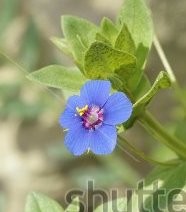Scarlet pimpernel
(Lysimachia arvensis arvensis)

Description
Anagallis arvensis (syn. Lysimachia arvensis), commonly known as the scarlet pimpernel, red pimpernel, red chickweed, poor man's barometer, poor man's weather-glass, shepherd's weather glass or shepherd's clock, is a species of low-growing annual plant with brightly coloured flowers, most often scarlet but also bright blue and sometimes pink. The native range of the species is Europe and Western Asia and North Africa. The species has been distributed widely by humans, either deliberately as an ornamental flower or accidentally. A. arvensis is now naturalised almost worldwide, with a range that encompasses the Americas, Central and East Asia, the Indian Subcontinent, Malesia, the Pacific Islands, Australasia and Southern Africa. Traditionally included in the primrose family Primulaceae, the genus Anagallis was placed in the family Myrsinaceae until that family in turn was included in Primulaceae in the APG III system. The genus Anagallis is included in Lysimachia by some authors. This common European plant is generally considered a weed and is an indicator of light soils, though it grows opportunistically in clay soils as well. The origin of the name pimpernel comes from late Middle English pympernele, derived from Middle French pimprenelle, from Old French piprenelle, and ultimately from Vulgar Latin *piperīnella (piper 'pepper' + -īn- '-ine' + -ella diminutive suffix). The flower serves as the emblem of the fictional hero the Scarlet Pimpernel. When found as a summer annual, the scarlet pimpernel has a low-growing creeping habit, but as a winter annual, it forms a half-rosette with an upright stem. It has weak sprawling stems with square cross-section growing to about 5–30 centimetres (2–12 in) long. They bear bright green, soft, ovate sessile leaves in opposite pairs. The orange, red or blue, radially symmetric flowers, about 10–15 millimetres (0.4–0.6 in) in diameter, are produced singly in the leaf axils from spring to autumn. The petal margins are somewhat crenate and have small glandular hairs. The stamens have lollipop hairs and therefore attract a variety of pollinators, especially flies, but the flowers are also capable of autopollination. The dehiscent capsule fruits ripen from August to October in the northern hemisphere. The weight of the fruiting body bends the stem, and the seeds are transported by the wind or rain.
Taxonomic tree:







